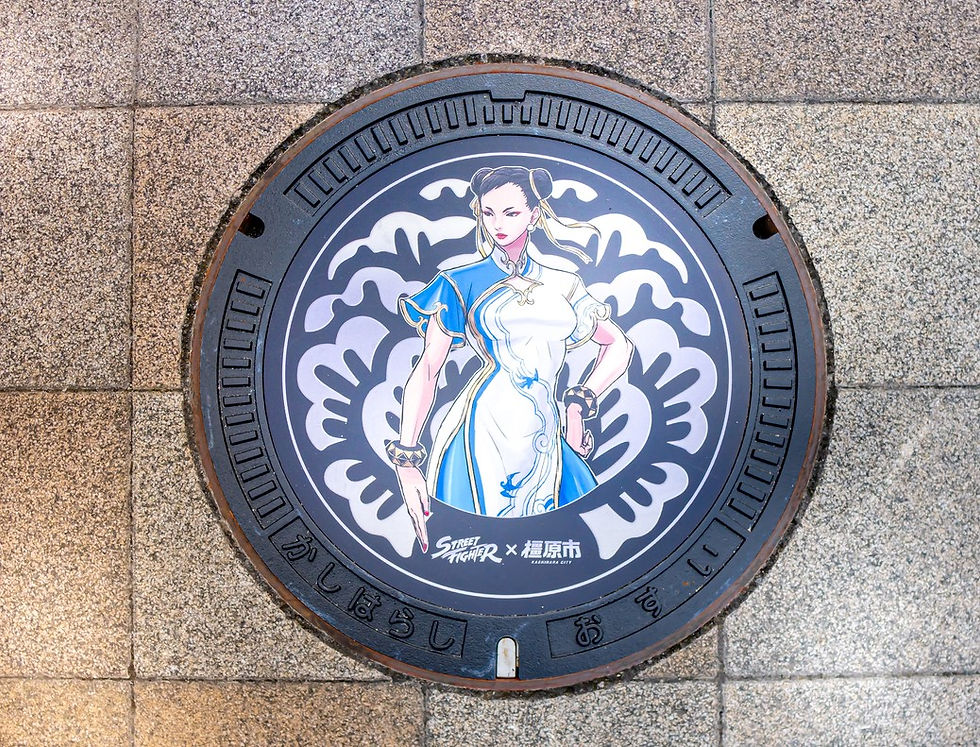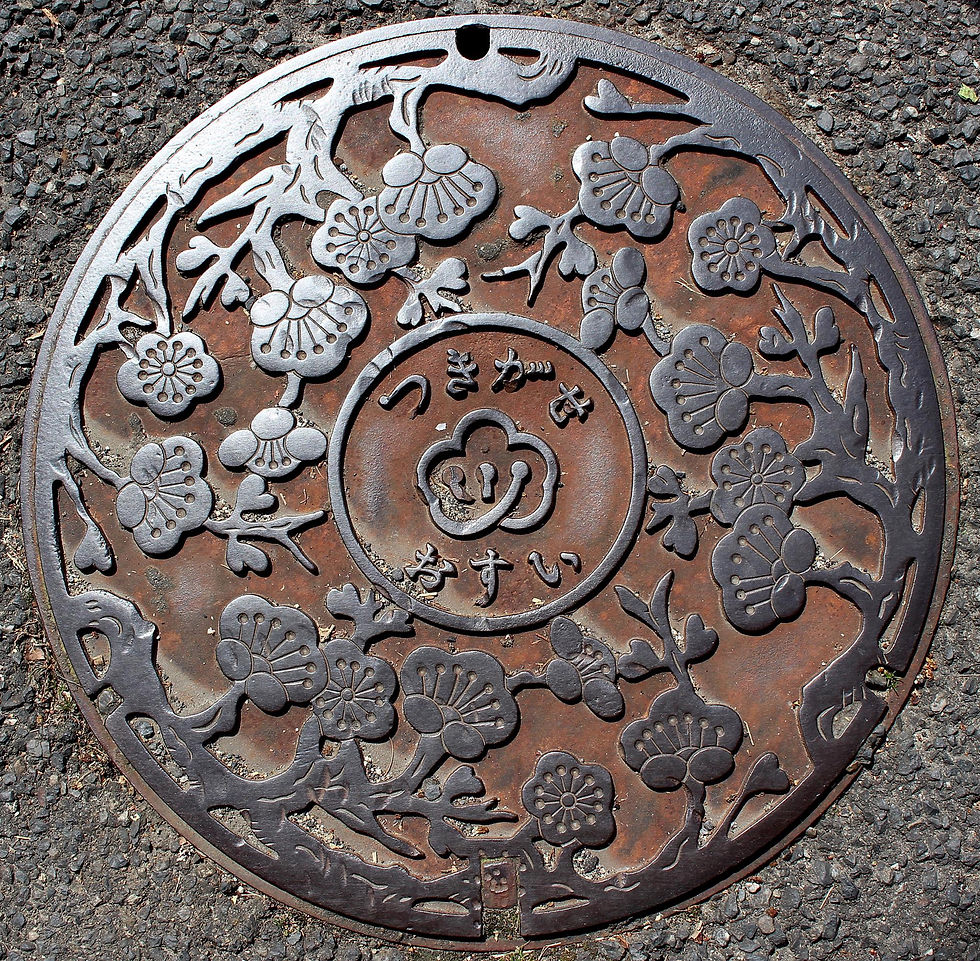Almost everywhere you go in Japan, there is a different manhole cover. Unlike the generic diamond plates or raised square patterns seen elsewhere, each town in Japan has its own unique design. These covers depict landmarks, festivals, or symbols of the local area—trees, landscapes, birds, and even famous historical scenes. This quiet yet deliberate creativity came about because of an idea that was, for once, both practical and inspired.

Evidence from archaeological sites suggests that Japan has had above-ground sewage and drainage systems since the Yayoi Period, approximately 2,200 years ago. These systems persisted for centuries, evolving alongside the needs of growing settlements. By the 19th century, however, modern underground sewer systems began to replace them. Introduced by Great Britain, these systems included manhole covers as a functional necessity. Japan's major cities quickly adopted the technology and built dedicated sewage networks. In contrast, rural areas struggled to follow suit due to the prohibitive costs of construction.

Koriyama Castle, Yamato-Koriyama City
By the 1980s, Japan’s economic boom had brought infrastructure projects to the forefront of public works. At that time, fewer than 60% of Japanese households were connected to sewage systems - a statistic that underscored the need for expansion into rural areas. Yet these projects faced significant resistance from local communities who balked at the high costs involved. To address this opposition and foster public support, Yasutake Kameda, a bureaucrat at the Construction Ministry, proposed an elegant solution: make the manhole covers - the only visible part of an otherwise hidden system - more visually appealing.

Nara City
Kameda’s idea was simple but effective. By encouraging municipalities to design their own manhole covers with motifs reflecting their local identity, he aimed to engage communities and highlight the importance of sewage infrastructure. Despite custom designs costing about 5% more than standard covers and requiring careful engineering to ensure functionality—such as maintaining traction for vehicles in wet or snowy conditions—the response was overwhelmingly positive. Designs poured in from across the country.

Yamato-Yagi Station, Kashihara City
Today, approximately 95% of Japan’s 1,780 municipalities boast their own unique manhole covers. Flowers and trees are among the most common motifs, but animals, landmarks, and local beauty spots are also prevalent. These covers serve purposes beyond sewage systems; they are used to cap storm drains, fresh water supply lines, fiber optic cables, fire hydrants, electric mains, and gas lines.For many visitors to Japan, photographing these artistic covers—an activity now known as "drainspotting"—has become a quiet yet rewarding pastime. Each cover tells a story about its region: a festival celebrated annually for centuries; a bird native to a particular forest; or a mountain that has watched over its people for generations.

Ikoma City
Unique Facts About Japan's Manhole Covers
Sheer Scale: Japan has approximately 15 million manhole covers with over 12,000 unique designs.
Manhole Cards: Collectible Manhole Cards have been issued since 2016 to promote tourism. Over a million cards have been distributed so far.
Pokémon Covers: Special Pokéfuta (Pokémon-themed manhole covers) have been installed in various locations since 2018 as part of a tourism initiative.
Glow-in-the-Dark Covers: Some municipalities have introduced glow-in-the-dark designs that enhance nighttime visibility while adding aesthetic appeal.
Craftsmanship: Each cover is crafted with care—designs are carved into wood molds before being cast in iron and painted by hand with durable resin-based pigments.
Annual Manhole Summit: Enthusiasts gather at this event to celebrate manhole art through exhibitions and trading card exchanges.
Cultural Significance: Designs often reflect local history and identity—Kyoto’s turtles symbolize wisdom and longevity; Hiroshima features its baseball team alongside maple leaves.
Global Influence: The phenomenon has inspired similar initiatives abroad in countries like China and the U.S., where enthusiasts document their own 'drainspotting' adventures.

Nara City
Nara Prefecture's Manhole Covers
Nara Prefecture, steeped in its rich history and cultural heritage, has also embraced the artistry of manhole covers as a reflection of its identity. Across the region, these covers serve as subtle yet striking markers of local pride, blending natural beauty, historical significance, and even playful modernity. In Nara City itself, many manhole covers feature the iconic free-roaming deer of Nara Park—a symbol of peace and harmony that has become synonymous with the area. These designs often incorporate cherry blossoms (yaezakura), the city’s official flower, alongside other natural motifs that evoke the serene beauty of the region.

Imai-cho, Kashihara City
In smaller towns like Ikaruga, manhole covers depict Japanese black pine and camellia flowers, as well as Horyu-ji Temple, a UNESCO World Heritage Site. Each design tells a quiet story about the place it represents, offering a glimpse into the prefecture’s deep connection to its history and landscape.But Nara’s manhole art is not confined to tradition. In recent years, it has embraced a playful twist with Pokémon-themed designs known as Pokéfuta. Installed in Ikaruga as part of a nationwide tourism initiative, these covers feature Pokémon like Deerling, Growlithe, and Bellsprout—characters chosen to resonate with Nara’s natural and cultural landscape.

Ikoma City
Deerling, with its gentle appearance, mirrors the deer that roam freely through Nara Park. These colorful covers have become attractions in their own right, drawing visitors eager to explore beyond the usual landmarks. Armed with maps to locate these artistic installations, travelers experience a delightful blend of modern pop culture and timeless regional charm.

Sango Town, Nara Prefecture
Elsewhere in Nara Prefecture, manhole covers highlight industries and stories unique to their communities. In Yamato-Koriyama, a city renowned for its goldfish cultivation, intricate goldfish motifs adorn the covers. These designs honor Yamato-Koriyama’s long-standing history as one of Japan’s leading producers of ornamental goldfish—a legacy sustained by over 50 breeders in the area. Visitors can spot these vibrant covers near landmarks like Koriyama Castle.

Kashihara-jingu Station, Kashihara City
In Kashihara City, manhole art takes on an entirely different tone—a playful intersection of pop culture and civic pride. Through a collaboration with Capcom, whose founder hails from Kashihara, the city introduced Street Fighter-themed manhole covers featuring iconic characters like Ryu and Chun-Li.

Yamato-Yagi Station, Kashihara City
These bold designs are positioned near key locations such as Kintetsu Yamato-Yagi Station and Kashihara-Jingu-Mae Station. They have become popular photo spots for fans of the legendary video game series while also celebrating Kashihara’s historical significance as the site of Japan’s first planned capital at Fujiwara-kyo. The partnership extends beyond manhole art to include statues, murals, and themed events—an inventive nod to modern gaming culture within a city rooted in ancient history.Together, these manhole covers tell a story about Nara Prefecture that is both deeply traditional and refreshingly contemporary.

Tsukigase, Nara City (Plum Blossoms)
The story of Japan’s manhole covers is not one of grand gestures or sweeping changes but rather one of thoughtful adaptation and community engagement. It is a story about finding beauty in utility and using that beauty to connect people—not only with their surroundings but with each other. Whether it’s through photographing a cover adorned with cherry blossoms or collecting a card featuring a Pokémon character tied to a specific region, these small details invite us to pause and appreciate the intersection of art and infrastructure in everyday life.
We plan to keep this list going and cover all areas of the prefecture. If you have any pictures you'd like to contribute, drop us a line.
Author: NARA Visitor Center & Inn

Comments